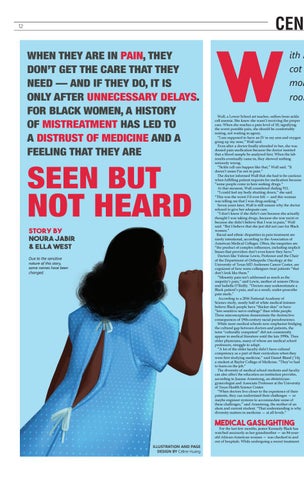CEN
12
WHEN THEY ARE IN PAIN, THEY DON’T GET THE CARE THAT THEY NEED — AND IF THEY DO, IT IS ONLY AFTER UNNECESSARY DELAYS. FOR BLACK WOMEN, A HISTORY OF MISTREATMENT HAS LED TO A DISTRUST OF MEDICINE AND A FEELING THAT THEY ARE
SEEN BUT
NOT HEARD STORY BY Noura Jabir & Ella West Due to the sensitive nature of this story, some names have been changed.
W
ith h cot mor
room
Wall, a Lower School art teacher, suffers from sickle cell anemia. She knew she wasn’t receiving the proper care. When she reaches a pain level of 10, signifying the worst possible pain, she should be comfortably resting, not waiting in agony. “I am supposed to have an IV in my arm and oxygen going up my nose,” Wall said. Even after a doctor finally attended to her, she was denied pain medication because the doctor insisted that a blood sample be analyzed first. When the lab results eventually came in, they showed nothing seriously wrong. “Sickle cell can happen like that,” Wall said. “It doesn’t mean I’m not in pain.” The doctor informed Wall that she had to be cautious when fulfilling patient requests for medication because “some people come in here seeking drugs.” At that moment, Wall considered dialing 911. “I could feel my body shutting down,” she said. “This was the worst I’d ever felt — and this woman was telling me that I was drug-seeking.” Seven years later, Wall is still unsure why the doctor refused to give her adequate care. “I don’t know if she didn’t care because she actually thought I was taking drugs, because she was racist or because she didn’t believe that I was in pain,” Wall said. “But I believe that she just did not care for Black women.” Racial and ethnic disparities in pain treatment are rarely intentional, according to the Association of American Medical Colleges. Often, the inequities are “the product of complex influences, including implicit biases that providers don’t even know they have.” Doctors like Valerae Lewis, Professor and the Chair of the Department of Orthopedic Oncology at the University of Texas MD Anderson Cancer Center, are cognizant of how some colleagues treat patients “that don’t look like them.” “Minority pain isn’t addressed as much as the majority’s pain,” said Lewis, mother of seniors Olivia and Isabella O’Reilly. “Doctors may underestimate a Black patient’s pain, and as a result, under-prescribe pain meds.” According to a 2016 National Academy of Science study, nearly half of white medical trainees believe Black people have “thicker skin” or have “less sensitive nerve endings” than white people. These misconceptions demonstrate the destructive consequences of 19th-century racial pseudoscience. While more medical schools now emphasize bridging the cultural gap between doctors and patients, the term “culturally competent” did not consistently appear in medical literature until the late 1990s. Thus older physicians, many of whom are medical school professors, struggle to adapt. “A lot of the older faculty didn’t have cultural competency as a part of their curriculum when they were first studying medicine,” said Daniel Bland (`14), a student at Baylor College of Medicine. “They’ve had to learn on the job.” The diversity of medical school students and faculty can also affect the education an institution provides, according to Joanne Armstrong, an obstetriciangynecologist and Associate Professor at the University of Texas Health Science Center. “When doctors live closer to the experience of their patients, they can understand their challenges — or maybe engineer systems to accommodate some of these challenges,” said Armstrong, the mother of an alum and current student. “That understanding is why diversity matters in medicine — at all levels.”
MEDICAL GASLIGHTING
For the last few months, junior Kennedy Black has watched anxiously as her grandmother — an 84-yearold African-American woman — was checked in and out of hospitals. While undergoing a recent treatment
ILLUSTRATION AND PAGE DESIGN BY Celine Huang
